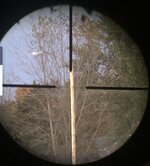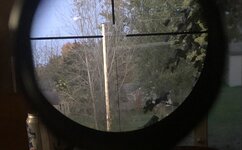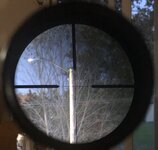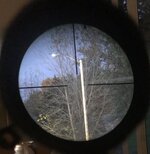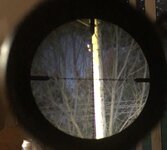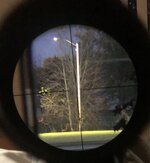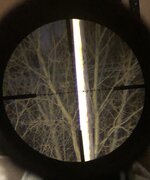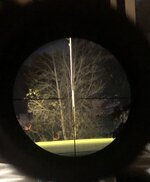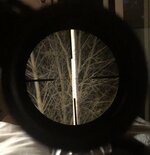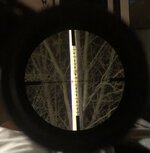Sure this will fire some folks up, but I wanted to start a thread to start compiling opinions and information on when first focal plane and second focal plane are advantageous. To date, I have had various levels of scopes but all were second focal plane. I am now looking to start shooting further distances and am interested in getting a first focal plane. Looking for pros and cons of both, cost aside.
You are using an out of date browser. It may not display this or other websites correctly.
You should upgrade or use an alternative browser.
You should upgrade or use an alternative browser.
First Focal Plane vs Second
- Thread starter TroutTail
- Start date
BRTreedogs
WKR
2nd Focal pro reticle is easier to see on lower power.
1st Focal pro the subtensions are correct at any power.
Thats pretty much it man.
You just have to decide of the reticle always being the same size or the hash marks always being the same is more important to ya.
1st Focal pro the subtensions are correct at any power.
Thats pretty much it man.
You just have to decide of the reticle always being the same size or the hash marks always being the same is more important to ya.
Gatorgrizz27
WKR
Not sure how much research you’ve done, but I don’t see FFP being majorly beneficial for modern hunting.
To my knowledge, they were developed when the military was using the reticle hash marks for ranging targets (humans). With FFP, the distance between the marks would remain consistent, regardless of magnification. 2’ is 2’, the width of an average man’s shoulders, look at what power you’re on, that’s how far away he is. Now dial or hold over and shoot.
The advent of inexpensive and reliable handheld rangefinders means nobody really has to range with their scope any more. I can really only see using it as a “check” if your rangefinder gives you a number that seems absurd.
With a SFP scope, the mil or MOA hash marks are only accurate at max power (typically). On a 3-9 scope shooting far enough to hold over, you’re likely to be zoomed in all the way anyhow, so it’s no big deal.
Now that we have 3-18, 4-16 etc scopes becoming more popular, you might not want to shoot at max power much, but most of them now come with ballistic turrets. If you have to hold over with a snap shot, holding on the spine or slightly above the animal is likely “good enough” if you know your drops, and faster than counting hash marks.
Wind holds would be a plus for FFP, if you have the experience to read it correctly and calculate the right windage. If you’re just holding a little left or right, I don’t see it mattering. If you miss and can see a bullet impact near a hash mark, just hold that on target, regardless of what the math works out to be.
The downside to FFP is the reticle thickness increases with magnification. At the low end it might be almost impossible to see in dim conditions, and at high power it may grow enough to completely cover a groundhog at 600 yards.
That is the opposite of what you want as a hunter, IMO. I prefer a heavy reticle when in dark timber making 25 yard shots at animals running by, using low power obviously, and a thin reticle when taking shots at small targets at long range, zoomed all the way in.
So my answer is the tactical stuff doesn’t always transfer well. A sniper engaging someone up close is likely to just use their handgun, if their spotter or other team member doesn’t handle it first.
To my knowledge, they were developed when the military was using the reticle hash marks for ranging targets (humans). With FFP, the distance between the marks would remain consistent, regardless of magnification. 2’ is 2’, the width of an average man’s shoulders, look at what power you’re on, that’s how far away he is. Now dial or hold over and shoot.
The advent of inexpensive and reliable handheld rangefinders means nobody really has to range with their scope any more. I can really only see using it as a “check” if your rangefinder gives you a number that seems absurd.
With a SFP scope, the mil or MOA hash marks are only accurate at max power (typically). On a 3-9 scope shooting far enough to hold over, you’re likely to be zoomed in all the way anyhow, so it’s no big deal.
Now that we have 3-18, 4-16 etc scopes becoming more popular, you might not want to shoot at max power much, but most of them now come with ballistic turrets. If you have to hold over with a snap shot, holding on the spine or slightly above the animal is likely “good enough” if you know your drops, and faster than counting hash marks.
Wind holds would be a plus for FFP, if you have the experience to read it correctly and calculate the right windage. If you’re just holding a little left or right, I don’t see it mattering. If you miss and can see a bullet impact near a hash mark, just hold that on target, regardless of what the math works out to be.
The downside to FFP is the reticle thickness increases with magnification. At the low end it might be almost impossible to see in dim conditions, and at high power it may grow enough to completely cover a groundhog at 600 yards.
That is the opposite of what you want as a hunter, IMO. I prefer a heavy reticle when in dark timber making 25 yard shots at animals running by, using low power obviously, and a thin reticle when taking shots at small targets at long range, zoomed all the way in.
So my answer is the tactical stuff doesn’t always transfer well. A sniper engaging someone up close is likely to just use their handgun, if their spotter or other team member doesn’t handle it first.
- Thread Starter
- #4
The thickness and impact at light conditions is something I had not heard before and a major factor. I just bought a swaro with the the ballistic turret system with the colors for crayon eaters like me. I am hoping it will be the right balance for my current knowledge and skill set.Not sure how much research you’ve done, but I don’t see FFP being majorly beneficial for modern hunting.
To my knowledge, they were developed when the military was using the reticle hash marks for ranging targets (humans). With FFP, the distance between the marks would remain consistent, regardless of magnification. 2’ is 2’, the width of an average man’s shoulders, look at what power you’re on, that’s how far away he is. Now dial or hold over and shoot.
The advent of inexpensive and reliable handheld rangefinders means nobody really has to range with their scope any more. I can really only see using it as a “check” if your rangefinder gives you a number that seems absurd.
With a SFP scope, the mil or MOA hash marks are only accurate at max power (typically). On a 3-9 scope shooting far enough to hold over, you’re likely to be zoomed in all the way anyhow, so it’s no big deal.
Now that we have 3-18, 4-16 etc scopes becoming more popular, you might not want to shoot at max power much, but most of them now come with ballistic turrets. If you have to hold over with a snap shot, holding on the spine or slightly above the animal is likely “good enough” if you know your drops, and faster than counting hash marks.
Wind holds would be a plus for FFP, if you have the experience to read it correctly and calculate the right windage. If you’re just holding a little left or right, I don’t see it mattering. If you miss and can see a bullet impact near a hash mark, just hold that on target, regardless of what the math works out to be.
The downside to FFP is the reticle thickness increases with magnification. At the low end it might be almost impossible to see in dim conditions, and at high power it may grow enough to completely cover a groundhog at 600 yards.
That is the opposite of what you want as a hunter, IMO. I prefer a heavy reticle when in dark timber making 25 yard shots at animals running by, using low power obviously, and a thin reticle when taking shots at small targets at long range, zoomed all the way in.
So my answer is the tactical stuff doesn’t always transfer well. A sniper engaging someone up close is likely to just use their handgun, if their spotter or other team member doesn’t handle it first.
TNKnoxville
WKR
My sons and I have both. On my 300 win mag I had a 5x25 Burris Veracity FFP. The reticle was perfect at about 15 x for my shot at a elk last year at 505 yards but was not good at about 6x on my mule deer shot at last light. Impossible to see.
My sons have Burris Veracity 4x20 FFP on 7 mm mags. They kept it on about 6 x normally just to see the reticle. They had shots this year on cow elks at about 350 yards and turned it up to maybe 9 or 10 for a good reticle view. They are not sure if they like the FFP. More shooting this summer will tell. Their other rifles have SFP.
My 28 Nosler had a 3x15 Veracity FFP. My shot at a cow elk this year was 100 yards, not expecting that! My old eyes need at least a 5 or 6x to see the reticle clearly. Too much power for that close a shot at last light.
So I put a 3x18 SFP on my 300 win mag, put the 5x25 FFP on the 28 Nosler (suppose to be the long range gun) and am going to trade it to a friend in CO who loves to shoot coyotes and stuff at long range. FFP reticle is perfect for that.
I'm only going to use SFP going forward.
All guns have custom yardage turrets so we all dial and don't use the hash marks. I choose the Burris scopes as they had good glass, dial solid and have a longer tube for mounting using Talley rings. We all have longer than average LOPs. I don't like how high a rail and rings mount a scope.
Hope this helps.
My sons have Burris Veracity 4x20 FFP on 7 mm mags. They kept it on about 6 x normally just to see the reticle. They had shots this year on cow elks at about 350 yards and turned it up to maybe 9 or 10 for a good reticle view. They are not sure if they like the FFP. More shooting this summer will tell. Their other rifles have SFP.
My 28 Nosler had a 3x15 Veracity FFP. My shot at a cow elk this year was 100 yards, not expecting that! My old eyes need at least a 5 or 6x to see the reticle clearly. Too much power for that close a shot at last light.
So I put a 3x18 SFP on my 300 win mag, put the 5x25 FFP on the 28 Nosler (suppose to be the long range gun) and am going to trade it to a friend in CO who loves to shoot coyotes and stuff at long range. FFP reticle is perfect for that.
I'm only going to use SFP going forward.
All guns have custom yardage turrets so we all dial and don't use the hash marks. I choose the Burris scopes as they had good glass, dial solid and have a longer tube for mounting using Talley rings. We all have longer than average LOPs. I don't like how high a rail and rings mount a scope.
Hope this helps.
- Joined
- Sep 15, 2020
- Messages
- 671
The answer is that YOU are the ultimate deciding factor, but some characteristics of your scope will determine what is better.
If you shoot holds only and do not dial:
-Max Mag under 10x: SFP
-Max Mag between 10-15: SFP/FFP
-Max Mag greater than 15: FFP
If you dial only:
Pick the one you like
It's unlikely that you'll be in a situation where you need to "mil" a deer.
If you shoot holds only and do not dial:
-Max Mag under 10x: SFP
-Max Mag between 10-15: SFP/FFP
-Max Mag greater than 15: FFP
If you dial only:
Pick the one you like
It's unlikely that you'll be in a situation where you need to "mil" a deer.
MuleyFever
WKR
I have an FFP 3-15X and a SFP 2.5-10x. I just orders 2 new scopes that are SFP with a max power of 15x on both. I just dont really care for the FFP.
As a side note some SFP scopes will state what the sub tensions are at a lower power too so you can use it to hold wind if you got familiar with it.
As a side note some SFP scopes will state what the sub tensions are at a lower power too so you can use it to hold wind if you got familiar with it.
- Joined
- Sep 15, 2020
- Messages
- 671
I have an FFP 3-15X and a SFP 2.5-10x. I just orders 2 new scopes that are SFP with a max power of 15x on both. I just dont really care for the FFP.
As a side note some SFP scopes will state what the sub tensions are at a lower power too so you can use it to hold wind if you got familiar with it.
The value for an SFP scope that is 1:1 at max power will be:
Value x (Max Power/Current Power)= Value at Current Power.
You're welcome
JGRaider
WKR
I have and use both. Illuminated reticles easily solve the problem of lower powers and thin reticles when using FFP. It's a non issue for me.
I switched to FFP about 4 years ago and quickly came back to 2FP. I could not handle the busy reticles and I never used the Christmas tree stuff. Switched to the 2FP March scopes and haven't looked back. With the March you can still use the sub tension marks for wind holds, and I always dial for elevation. WIN, WIN
- Banned
- #13
- Banned
- #14
- Banned
- #15
sndmn11
"DADDY"
FFP means always useful in my mind. I won't buy SFP.
Don Qui Puncher
WKR
FFP MIL is the only thing my brain can compute
H
HuntnPack
Guest
SFP vs FFP
No Right or Wrong answer.
Boils down to intended use, personal preference, & scope features, operations, & utilization.
I prefer SFP for my hunting scopes. I prefer the reticle to remain constant in size & only the target/animal size to change with magnification. This provides a familiar & fast sight picture for me throughout the scopes magnification range.
I have developed a system for utilizing SFP subtension adjustments on my 4-32 NX8 with dual scaled reticle & location of the power throw lever for follow up shots that is fast & accurate on the rare occasion I need to.
In conjunction with my rangefinder, I primarily dial for distance & hold for wind, & make corrections either by dialing or holding for correction without changing power setting.
Utilize what works for each individual, the required use & become familiar with the scopes features, & operations.
No Right or Wrong answer.
Boils down to intended use, personal preference, & scope features, operations, & utilization.
I prefer SFP for my hunting scopes. I prefer the reticle to remain constant in size & only the target/animal size to change with magnification. This provides a familiar & fast sight picture for me throughout the scopes magnification range.
I have developed a system for utilizing SFP subtension adjustments on my 4-32 NX8 with dual scaled reticle & location of the power throw lever for follow up shots that is fast & accurate on the rare occasion I need to.
In conjunction with my rangefinder, I primarily dial for distance & hold for wind, & make corrections either by dialing or holding for correction without changing power setting.
Utilize what works for each individual, the required use & become familiar with the scopes features, & operations.
TyWeimer
FNG
For most hunting applications (especially big game) I see 2nd focal plane as superior. Easy to see reticle at any magnification and low light. The only time I’ve found 1st focal plane better is for coyote stands. Fast acquisition shots are needed, and having the proper sub tensions at any magnification really helps when it’s a action packed stand.
AZ_Hunter_2000
WKR
- Joined
- Oct 8, 2019
- Messages
- 2,956
Both work exceptionally well for putting the bullet where you want it to go.
Run what works best for you individually.
Run what works best for you individually.
Similar threads
- Locked
- Replies
- 2
- Views
- 288
- Replies
- 19
- Views
- 2K
- Replies
- 0
- Views
- 239
- Replies
- 8
- Views
- 690
Featured Video
Stats
Latest Articles
-
Kryptek Traverse Merino Review
-
First Lite 308 Pant Review
-
Argali Selway 6P Tent Review
-
AGC Kobuk 2800 Backpack Review
-
Hunting The Leaf-off Window
-
TT#41 Jordan Budd’s Tips on Finding and Killing the Big One
-
NEMO Hornet Elite Osmo 1P Tent Review
-
Rokcast Reload: Stories from a Wall Tent
-
Vote No On Prop. 127
-
Marlon Holden: High Level Mule Deer Stalking

